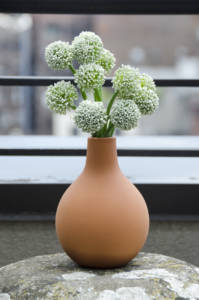
Ask Ella: The Curious Charm of Chives
Ask Ella is a recurring Garden Collage feature where we ask our in-house florist, Ella Stavonsky, about the history of, origin, and maintenance that goes into some of the most intriguing flowers on the market today. This column is dedicated exclusively to common and rare varieties of flowers you’re likely to find at your local market. This week, we spotlight chive flowers, which you can pick up fresh at the farmers’ market– or find in your own backyard.
***
Sometimes referred to more generally as allium (which is the larger genus that comprises garlic, onions, and chives), chive blossoms are a small, tightly-bunched blossoming flower that evokes the escape and light-heartedness of outdoor celebrations. In the summer months, chive blossoms are almost inescapable– it’s not unusual to see them lined up along fences or sprouting up unexpectedly in flower beds (even in an urban city like New York).
When brought out of the garden and into the home, chive blossoms should be kept in cool water (refreshed each day) and out of direct sunlight. Be sure to clip the stems when you change the water as well– but be warned that chive blossoms will release a tangy, onion-y scent.
In arrangements, chive blossoms lend themselves well to bouquets that have a spontaneous, picked-fresh-from-the-garden feel, so try mixing them with wilder-looking flowers like daisies or clematis. You can mask chive blossoms’ onion scent with a bit of sage or mint (the contrast of green leaves also sets off their color nicely). For outdoor summer dinner parties, chive blossoms keep the garden’s beauty and bounty close at hand– plus, when paired with herbs, chive blossoms make an entirely edible bouquet!


































